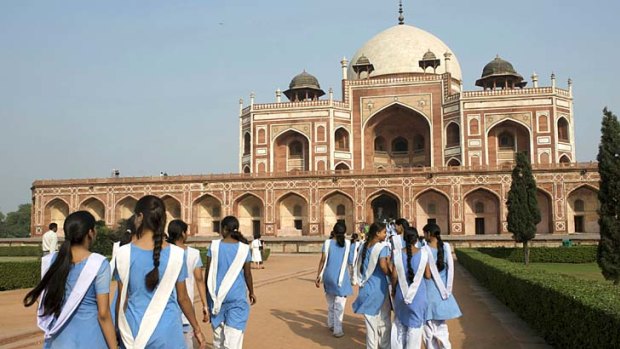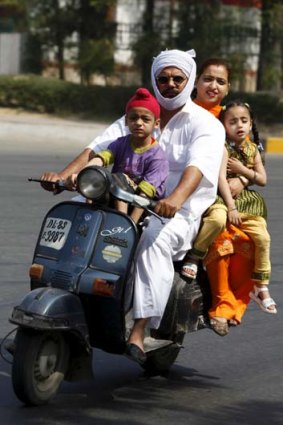This was published 12 years ago
An epic entanglement
Fiona Duncan makes sense of chaotic, colour-soaked, contemporary Delhi by discovering its noble past.

Humayun's Tomb is Dehli's Taj Mahal.Credit: AFP
I AM standing on the roof of a tall, narrow house, high above the seething interior of Chandni Chowk in Old Delhi. The house is home to seven families, including a former mud wrestler, Mohammed, who is exercising his precious flock of thoroughbred pigeons, dosing them with his secret brew of spices and raisins and commanding them with hoots and whistles to fly or return.
His dearest wish is to tempt the pigeons of rival kaboortarbaaz (pigeon flyers) away from their flocks; we can see them, along with many eagles, wheeling in tight arcs in different parts of the city sky.
Not long after, I am sitting quietly on the floor of a Sikh temple, where beneath a pink silk canopy, a priest gently sweeps the air above the holy scripture, set on a golden altar, with a long-handled horsehair brush.

A family pack onto a scooter and brave the traffic in New Delhi.Credit: AFP
In a city built and destroyed seven times and filled with a multitude of historic ruins, I visit the great monuments of Qutub Minar, the Red Fort, Jama Masjid (mosque), Humayun's Tomb - the equal of the Taj Mahal - and Rajghat (site of Gandhi's cremation and memorial). I hear the stories and gradually piece together a picture of Delhi's inhabitants, whose varied faces, whether watchmaker or beggar, car-part vendor or spice seller, cloth merchant or street-food cook, speak of a centuries-old fusion of different, far-flung peoples.
Later, I play with bouncing children at a charity-run school and health clinic, the Hope Project, and plunge into the colour-soaked, pilgrim-choked all-night bazaar around the Dargah (mausoleum) of Nizamuddin. The ancient stepwell may be full of holy water but it is also full of sewage, the only outlet for the surrounding neighbourhood, deeply impoverished but engrossing, filled with pilgrims, revered tombs, busy markets and devotional singing (if you are lucky you will catch Sufis singing qawwalis, designed to raise the listener to a state of trance).
I experienced all these things and so much more, in just three days. Most visitors to India only have days at their disposal before pressing on to other parts of the country, but often want to discover something of the "real" Delhi with the trappings of a spoiling holiday.
With the help of private guides, that can be achieved and sprawling, confusing, impenetrable Delhi becomes instead a many-layered, unforgettable collage of colour and sound, startling beauty and troubling truth.
It was a guide, himself an extraordinary man, an academic and poet who speaks 11 languages and withdraws to a cave for three months each year, who led me onto the rooftops and into the maze of alleys and bazaars in Old Delhi; and it was a guide who took me beyond the firmly closed gates of the president's palace in New Delhi.
A century ago, at that British Raj extravaganza, the 1911 Delhi Durbar, King George V was anointed emperor of India and announced the shift of capital city from Calcutta to Delhi. Soon after, Sir Edwin Lutyens set sail from England and began to create New Delhi and its viceregal - now government - buildings, along with fellow architect Herbert Baker, with whom he later quarrelled.
It is Lutyens whom we have to thank for broad, tree-lined avenues and the roundabouts, for imposing India Gate and, above all, for Rashtrapati Bhavan, the presidential palace that crowns Raisina Hill. Lutyens and Baker fell out over the gradient of the approach to the palace at the point where it is flanked by Baker's twin Secretariat buildings: here, Baker made the slope so steep that Lutyens's palace suddenly disappears from view.
"I met my Bakerloo," Lutyens, who was famed for his one-liners, later quipped.
In the same vein, the nearby diplomats' bungalows, designed by Baker rather than him, were written off as "bungle-ohs".
Climb Baker's notorious slope, reach the delicate gates of the palace and content yourself with peering through the wrought ironwork at Lutyens's masterpiece of clarity and proportion in the distance, with its equally harmonious, rational and beautiful Mughal Gardens hidden beyond.
Or, alternatively, choose a good tour operator or a top hotel whose concierge will, as mine did, secure in advance the special permission necessary for the privilege of a private tour of both the palace and the gardens.
The luxurious, gracious hotel to which I was able to retreat and take stock each afternoon, and which organised my itinerary, was the Leela Palace, purpose built in the style of Lutyens and recently opened, with a much-envied central location in the Diplomatic Enclave.
An airy, delicate, Mughal-pretty haven of marble and glass, with touches of pink and gold, it has four restaurants; an intimate library bar; flower-filled terraces and gardens; a secretive, labyrinthine Espa spa; elegant, superbly equipped bedrooms and divine bathrooms that I could not fault; as well as gentle, attentive, personal service.
Each morning, I set out from Leela Palace for another adventure and a constant slide show of never-to-be forgotten images.
A painted eunuch begs at one set of traffic lights, a child contortionist at another; women in glittering saris perch side-saddle behind their husbands on tooting scooters amid whirling traffic; families of four sit in rows astride motorbikes; street food is ladled from vast urns or scooped from deep ovens; astonishing, intricately carved Mughal facades and arches punctuate ramshackle alleys; goats devour plastic and leap onto cars; chickens in cages and groups of little uniformed schoolchildren in carts are towed behind rickshaws; a barber cuts hair beneath a tree, mirror nailed to the trunk; teenage girls and boys slyly eye each other from the rooftops where the pigeons fly.
But somehow, of all these images, it's my visit to neglected, almost forgotten Coronation Park that remains most fixed in my mind, especially in this Delhi centenary year.
It was here that the Durbar of 1911 was held in all its elephant-packed pomp and the king made his declaration that Delhi would become India's capital.
Now reduced to a scruffy playing field for numerous impromptu games of cricket, Coronation Park is set around an obelisk declaring George V as emperor of India.
In a locked garden, poking up through the tangled overgrowth, stands a semicircle of huge marble statues on plinths, including those of George and Queen Mary, the last in a long line of conquerors who are now consigned to Delhi's blurred and distant history, leaving the people to roll on, apparently accepting their lot.
Trip notes
Getting there
Malaysia Airlines flies from Sydney to Delhi via Kuala Lumpur, priced from $1447. 13 26 27, malaysiaairlines.com. Singapore Airlines, Qantas and Thai Airways also fly from Sydney to Delhi, via Asian hubs.
Staying there
Amarya Haveli is a stylish guest house run by a French couple. Good food and roof terrace. Doubles from $144. +91 11 4175 9267, amaryagroup.com.
The Manor, tucked away in a leafy, upmarket residential suburb, is a 15-room '50s bungalow with slick, contemporary interiors and a cutting-edge restaurant, Indian Accent. Doubles from $200. +91 11 2692 5151, themanordelhi.com.
ITC Maurya Sheraton has excellent restaurants, a fine spa and an arresting mural-clad dome above the lobby. Doubles from $325. +91 11 2611 2233, www.itcwelcomegroup.in .
The Leela Palace Kempinski New Delhi is set to outshine the competition with its glamorous interiors and state-of-the-art facilities. Doubles from $530. +91 11 3933 1234, theleela.com.
Eating there
Karim's, close to Delhi's largest mosque, serves authentic Mughal cuisine. 16 Jama Masjid, +91 11 2326 4981.
Punjab Grill is superb yet informal, using the freshest of produce and the finest meat. Select City Walk Mall, +91 11 4157 2977.
Bukhara is world famous but also great fun, with aproned diners eating superb tandoori dishes with their fingers in convivial surroundings. ITC Maurya, +91 11 2611 2233.
Touring there
Specialist guide Surekha Narain offers tailor-made heritage walks and numerous private visits. delhimetrowalks.com.
The Salaam Baalak Trust for street children offers unforgettable city walks, guided by older children trained as guides. salaambaalaktrust.com.
More information
delhitourism.nic.in, incredibleindia.org.
Top tips
To avoid an upset stomach, stick to bottled water (drink plenty) and avoid unpeeled fruit, vegetables and salads.
Do not give money to beggars, however upsetting you find their circumstances. You risk being surrounded and it's best to give to a suitable charity, such as the Hope Project (hopeprojectindia.org) instead.
On guided tours, dress modestly and carry a scarf and respectable socks for mosque and temple visits.
Avoid running out of baksheesh (small change/notes) — everyone hopes for a tip, from the shoe-keeper at the mosque upwards.
If you have a driver, don't lose him: take your mobile and keep a record of his phone and licence-plate numbers.
Avoid the shopping malls: though many restaurants and shops are found in them, they are Westernised and atmosphere-free.
The best time to visit for both the weather and the festivals is autumn and winter, October to March, when the nights are cool and the days are sunny. Avoid the heat of summer and the rainy season, which is from April to September.
Sign up for the Traveller Deals newsletter
Get exclusive travel deals delivered straight to your inbox. Sign up now.